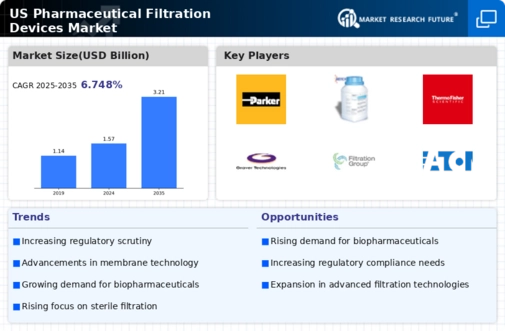Growing Demand for Sterile Products
The pharmaceutical filtration-devices market is experiencing a notable increase in demand for sterile products, driven by the rising need for safety and efficacy in drug manufacturing. As the industry shifts towards more complex biologics and sterile injectables, the requirement for advanced filtration solutions becomes paramount. In 2025, the market for sterile filtration devices is projected to reach approximately $2 billion, reflecting a compound annual growth rate (CAGR) of around 8%. This growth is indicative of the heightened focus on contamination prevention and the need for stringent quality control measures in pharmaceutical production. Consequently, manufacturers are investing in innovative filtration technologies to meet these evolving demands, thereby propelling the pharmaceutical filtration-devices market forward.
Rising Incidence of Chronic Diseases
The pharmaceutical filtration-devices market is being driven by the rising incidence of chronic diseases, which necessitates the development of new therapeutic solutions. As the prevalence of conditions such as diabetes, cancer, and cardiovascular diseases increases, pharmaceutical companies are under pressure to innovate and produce effective treatments. This demand for new drugs correlates with a heightened need for reliable filtration devices to ensure product safety and efficacy. In 2025, the market is projected to grow by 5% as companies ramp up production to meet the needs of an aging population and the growing burden of chronic illnesses. This trend indicates that the pharmaceutical filtration-devices market will play a crucial role in supporting the development of new therapies aimed at addressing these health challenges.
Focus on Environmental Sustainability
The pharmaceutical filtration-devices market is increasingly influenced by a growing focus on environmental sustainability. As regulatory bodies and consumers alike emphasize the importance of eco-friendly practices, pharmaceutical companies are seeking filtration solutions that minimize waste and reduce environmental impact. This shift is prompting manufacturers to develop filtration devices that are not only efficient but also sustainable. In 2025, it is estimated that the market for environmentally friendly filtration solutions will grow by approximately 6%, reflecting the industry's commitment to sustainability. This trend suggests that the pharmaceutical filtration-devices market will continue to evolve, with an emphasis on products that align with environmental goals while maintaining high standards of quality and safety.
Technological Advancements in Filtration
Technological advancements are significantly influencing the pharmaceutical filtration-devices market, as innovations in filtration technologies enhance efficiency and effectiveness. The introduction of advanced membrane technologies, such as microfiltration and ultrafiltration, allows for improved separation processes, which are crucial in the production of high-quality pharmaceuticals. In 2025, the market is expected to witness a surge in the adoption of these technologies, with a projected growth rate of 7% annually. This trend suggests that manufacturers are increasingly prioritizing the integration of cutting-edge filtration solutions to optimize production processes and ensure compliance with regulatory standards. As a result, the pharmaceutical filtration-devices market is likely to benefit from these technological enhancements, leading to improved product quality and operational efficiency.
Increase in Pharmaceutical R&D Investments
The pharmaceutical filtration-devices market is poised for growth due to the increase in research and development (R&D) investments within the pharmaceutical sector. As companies allocate more resources towards developing new drugs and therapies, the demand for effective filtration solutions becomes critical. In 2025, R&D spending in the pharmaceutical industry is anticipated to exceed $200 billion, which will likely drive the need for advanced filtration devices to ensure the purity and safety of new products. This trend indicates that as the pipeline of innovative therapies expands, the pharmaceutical filtration-devices market will experience a corresponding increase in demand, necessitating the adoption of sophisticated filtration technologies to support R&D efforts.

















Leave a Comment